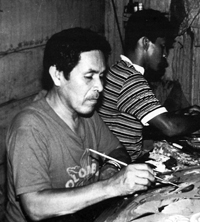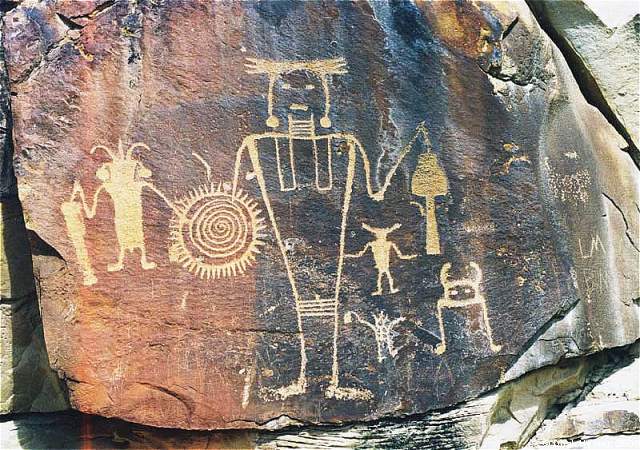Shamanism & Rites of Passage
Monday, 21st May 2012
This weeks topic, Shamanism was always going to be an exciting knowledge stream for me, as I've often wondered in awe, having seen references to them on travel programmes on TV. The below notes briefly outline:
Before discussing this weeks class notes I'll detail my own ongoing personal experiment, to perform a few Random Acts of Kindness each week throughout the 10 week duration of this course. You may recall I struggled with just 5 last week and having taken my eye off the ball, I realised that maybe focusing too much can also be problematic ...to the extent that I only managed one (1) single act this week! Oh dear. In future, I'll trust my instincts and just see what opportunities present themselves in an effort to increase my score :-)
- The Shaman
- Ancient roots of Shamanism
- Characteristics of a Shaman
- How a Shaman is chosen
- Shamanic initiation
- The healed healer
- Crucial roles
- Shamanic abilities
- Rituals
- Art work
Before discussing this weeks class notes I'll detail my own ongoing personal experiment, to perform a few Random Acts of Kindness each week throughout the 10 week duration of this course. You may recall I struggled with just 5 last week and having taken my eye off the ball, I realised that maybe focusing too much can also be problematic ...to the extent that I only managed one (1) single act this week! Oh dear. In future, I'll trust my instincts and just see what opportunities present themselves in an effort to increase my score :-)
- 16th May - A few years ago, whilst surfing I met a guy whose wife was on the sand, taking pictures. With an interest in photography we exchanged words and later had the opportunity to exhibit some work together as part of a local surf art show. During this and a second exhibition we became new friends and I now regularly surf with her husband and comment on her pictures on Facebook. We provide one another with friendly competition as well as support. Now in her fifties I learned that as a teenager she was a very talented sportswoman but was knocked off her bicycle by a car, resulting in a spinal injury, permanent disability and years of subsequent depression. She has endured many sacrifices e.g. her sport, the ability to travel, children etc but has persevered and I look up to her mental strength and courage. Not having seen her at the beach for some time (three years ago she had a special support bed made to travel in her van, not having been able to travel for decades before that) I decided to send her a supportive email, saying how much I missed her fine photographs and cheeky company and that we must team up again sometime soon. She responded the same day saying how very grateful she was for my "kind words", empathy and encouragement. Her father has been diagnosed with terminal cancer and only a few months to live. He's taken it very badly and she, despite her disability has been spending all her time tending to her elderly parents at this trying time. I could tell from her email that she was buoyed up by my contact and that we'll definitely all get together this Summer, at the beach. I felt very happy, given I had no prior knowledge of her fathers illness, that I'd taken a few minutes, based on no more than intuition, to help raise her spirits.
...and so to Shamanism.
The Shaman
- Wise man.
- Supernatural healer and master of the spirits.
- Communicates with the world beyond, to help diagnose and heal, and to use ESP to foretell the future.
- View happenings in far off places.
- Consulted in all rites of passage e.g. the naming of children, vision quests or puberty ceremonies, births, deaths and marriages.
- Considered a healer, a philosopher and a priest.
- Can take on male or female spiritual transformations.
The Ancient Roots of Shamanism
- Traced back to Paleolithic era via ancient European cave paintings.
- A Universal presence; found all across the world.
"The word shaman is derived from a Tungus word meaning "he who knows."
(The Tungus are a people who originated in the Amur River valley and spread
into northeastern Asia). Associated with the shaman is the dance. The shaman dances as a way to experience another realm of consciousness (see The Power of Myth, Doubleday, 1988 @ pp. 85-87)"
Characteristics of a Shaman
- One who is spiritually alive, who can experience different levels of existence in everyday reality.
- A mediator between worlds.
- A restorer of balance.
- One who can appreciate and understand the interconnectivity of everything in life.
The above link is to a good documentary introducing the Shaman of the Amazon. It's easy viewing and at 50 mins duration it provides an insight into one tribes ritualistic lifestyle, providing an excellent overview into their spiritual practises.
Aspects
- A recognition that all is divine.
- A total love for and respect of nature.
How is a Shaman chosen?
- Certain signs are sometimes seen at the birth of a child, indicating their destiny e.g. partial disfiguration, such as being born with teeth, or six fingers on a hand.
- The lineage may pass down through generations of the same family.
- Some children are noticeably attracted to the path from a very early age, displaying a wisdom belaying their years.
- Individuals may be identified to a Shaman during a dream or a visionary state. This may also occur to the individual, in a vision quest during a rites of passage ceremony.
- May be identified as someone who has nearly died, through accident or illness.
Shamanic Initiation
- Usually takes place alone, in a remote and hostile environment e.g. a cave or mountain top.
- Involves the journey to death, resurrection, illumination or realisation.
- May involve an encounter with death that results in rebirth.
- Only the strongest will survive the rigorous, arduous initiation. Many die in the process e.g. being tied naked to a tree in bitterly cold winds, often starved of food for very long periods of endurance.
- Enter into an altered state, dismemberment of body in a temporary state of death, followed by rebirth.
- To learn the art of dying and that of spirits having consumed their flesh during which time they are given knowledge of certain ailments and diseases.
The Healed Healer
- Their initial trauma allows them to achieve control over their spirits, who then transform them into a healer, the Shaman.
- The healed healer has retrieved the pieces of his broken psyche.
- Undergoes personal transformation allowing integration between the many planes of life experience; the body and spirit, the individual and community, nature and the supernatural, mythic and historical, the past, present and the future.
- Experiences a breakdown of ego and defences, to reintegrate and reconstruct the ego.
The Critical Role of the Shaman
- To learn to integrate the experiences of sickness, suffering, dying and death.
- To share knowledge of these powerful events with those who face death or disease for the first time.
Shamanic Abilities
- A clairvoyant with the ability to diagnose illness.
- The ability to psychically learn other persons secrets.
- To control the weather.
- To walk on fire.
- To have premonitions of the future.
- To discover the perpetrators of crimes.
- To locate and find lost objects.
- To undertake voluntarily, spirit possession.
- All Shaman must undertake ESP tests before they are allowed to train.
The above link is to an hour long documentary entitled Shamanism - Other Worlds. I found it extremely informative as an historical as well as contemporary account of spiritual awareness around the globe, as well as being very insightful, well made and above all, thought provoking.
Shamanic Rituals
- Ceremonies and ritualistic practise is often accompanied by drumming
- Shaking the Shaman's rattle
- Chanting
- Fasting
- Ingestion of mind altering substances e.g.the ayahuasca plant
- Temperature regulation
- Sensory deprivation
- Sleep deprivation
- Yawning - to let the spirits into the body through the mouth.
Shamanic Art
Some Shaman portray their journeys and experiences through art. One modern example is that of Pablo Amaringo , a Peruvian artist. See link for Wikipedia biography.
 |
| Pablo Cesar Amaringo (1938-2009) |
The below picture is an example that links to a gallery of his work and his last book (2003) can be found here, Ayahuasca Visions: The Religious Iconography of a Peruvian Shaman - the works clearly emphasise the spiritual connection between the natural world and its healing powers.
In conclusion
A most rewarding and fascinating lecture that has forged in me a passion to travel and experience diverse cultures. I believe that all too often in the Western world we are lead down the line of pharmaceutical drugs by the industry machine that lurks behind the national health services. This capitalist approach leaves little room for natural healing and as a society I think we're being forced away from our ancestral past. The wonder of this course is that it continues to open my eyes to new, albeit alternative and ancient ideals, which to me seem more than useful in combatting the stresses and strains of modern living. I can now say for definite that I'm on a new spiritual path ...and I can't wait for our next session. Surely the 20 week degree module is reason enough to sign up for September's BA (Hons) Humanities course!
"Treat the earth well: it was not given to you by your parents, it was loaned to you by your children. We do not inherit the Earth from our Ancestors, we borrow it from our Children."Ancient Indian Proverb






